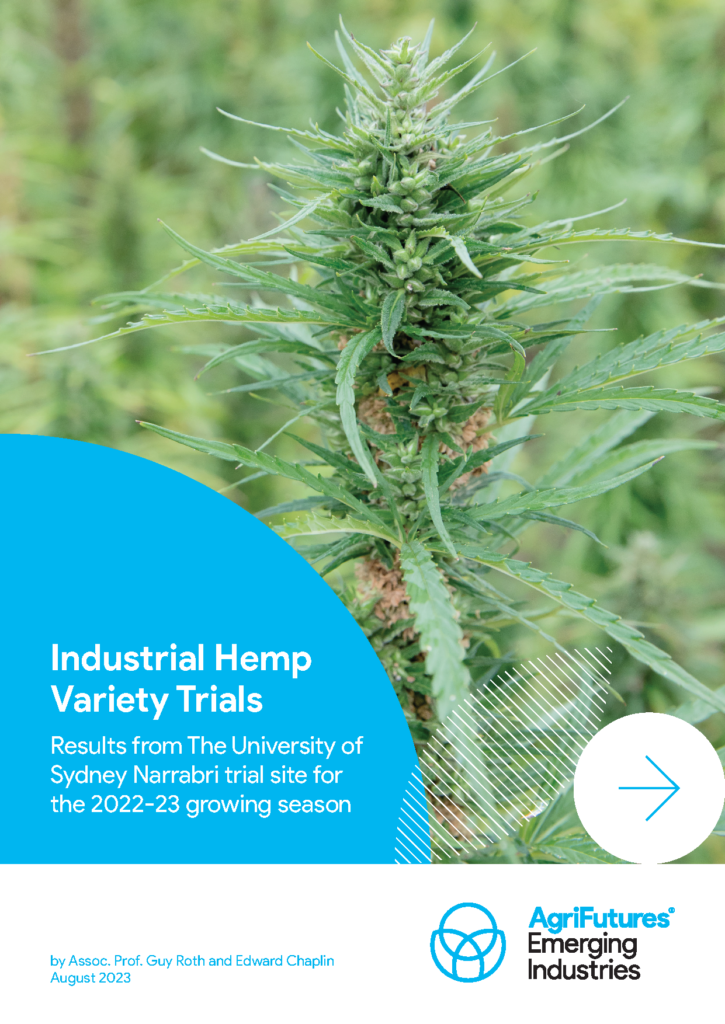Impact case study: Hazelnut investments give confidence to new growers
Australia’s peak hazelnut industry body says the number of growers in Australia is steadily increasing, as ongoing research and development efforts give potential new entrants...

58 pages
Published: 22 Dec 2023
Author(s): Guy Roth, Edward Chaplin
ISBN: 978-1-76053-457-8
Download report PDF
DownloadPurchase a hard copy - AUD $50
AgriFutures Australia has determined that industrial hemp (Cannabis sativa L.), i.e. low tetrahydrocannabinol hemp, has high growth potential due, at least in part, to its diverse uses and sustainability credentials.
Against this backdrop, the AgriFutures Emerging Industries Program has invested in a series of variety trials to understand the crop’s performance across Australia. The Industrial Hemp Variety Trials (IHVT) program aims to provide Australian hemp growers with independent information about different varieties suited to different farming regions within Australia. This second year of the program includes sites in the Northern Territory, South Australia (2), Tasmania, Victoria, Western Australia (2), New South Wales and Queensland.
In this first trial conducted by The University of Sydney at its Narrabri site in 2022-23, started during the second year of the IHVT program, nine varieties were sown at three times of sowing (TOS), with three replicates for each treatment. TOS 1 was 8 December 2022, TOS 2 was 9 January 2023 and TOS was 28 March 2023.
Despite adequate soil moisture and irrigation, two times of sowing failed, with only TOS 1 being maintained through to harvest. The extreme soil temperatures, particularly for TOS 2 (>50 °C) was likely the main factor that led to poor germination and plant establishment. There were also low levels of arbuscular mycorrhizal fungi (AMF) in this field. This is characteristic of the condition referred to as ‘long fallow disorder’ and is likely to have contributed to the poor early plant growth. Moving forward, it is essential to address these challenges to enhance crop performance and ensure a viable hemp crop.
Grain yield ranged from 206 kg/ha (Henola-09) to 1,554 kg/ha (Ruby). Fibror-79 was close to this at 1,473 kg/ha. Harvest index remained consistent across varieties, however other factors varied significantly: dry matter biomass yield ranged from 1,100 kg/ha (Katani) to 8,270 kg/ha (Ruby); thousand grain weight ranged 6.22 g (Henola-09) to 12.98 g (Ruby); grain bulk density ranged 28.0 kg/hl (Henola-09) to 47.8 kg/hl (Ruby); protein content ranged from 17.4% (Henola-09) to 23.2% (Fibror-79); and oil content ranged from 6.9% (Henola-09) to 26.1% (Ruby). Ruby performed best in five out of six of these characteristics.
The nine varieties trialled produced both monoecious (each plant bears both male and female flowers) and dioecious (each plant is either male or female) plants. Bialobrzeskie-08, Fedora-17, Fibror-79, Henola-09 and Orion-33 were predominantly monoecious, with an average of 65% of plants being hermaphrodite (i.e. have both male and female reproductive organs) and a low number of male and female-only plants. By contrast, CFX-2, CRS-1, Katani and Ruby were mainly dioecious, with an average of 18% more female plants than male plants along with a small number of hermaphrodite plants. The longer-season varieties – Ruby (dioecious), Fibror-79 and Orion-33 (both monoecious) – correlated with taller plants, greater biomass and higher grain yield.
The best performers in this 2022-23 trial were Fibror-79 and Ruby. They demonstrated exceptional performance across various grain production and quality metrics. These varieties appear to be well-suited for the North West region of New South Wales. However, it’s essential to recognise that these findings are based on a single sowing time and one season. As each season presents unique challenges and opportunities, growers can leverage the insights gained from the nine sites in the IHVT program, which will continue next year encompassing different seasons and varied sowing dates, enabling informed varietal choices.